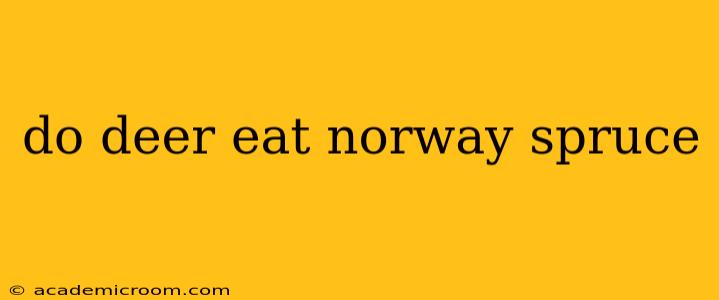Deer, with their voracious appetites, are known to browse a wide variety of plants, but the question of whether they consume Norway spruce is a bit more nuanced than a simple yes or no. While not a preferred food source, under certain conditions, deer will eat Norway spruce, especially parts of the tree. This article explores the factors that influence deer browsing on Norway spruce and answers some frequently asked questions.
What Parts of a Norway Spruce Do Deer Eat?
Deer are opportunistic browsers. While they won't typically strip a mature Norway spruce bare, they are more likely to target young, tender shoots and needles, especially during winter when other food sources are scarce. They might also nibble on lower branches that are easily accessible. The bark of young saplings is also sometimes consumed. It's important to note that the nutritional value of spruce needles is relatively low compared to other plants.
Are Norway Spruces Damaged by Deer?
The extent of damage depends heavily on several factors:
- Deer population density: High deer populations in a given area significantly increase the likelihood of browsing damage. More deer mean more mouths to feed, leading to greater pressure on available food sources, including Norway spruce.
- Availability of preferred food: If deer have access to plenty of their favorite foods (like clover, grasses, and certain shrubs), they are less likely to target Norway spruce. During winter months or in areas with limited food diversity, the situation shifts, making spruce more appealing.
- Age of the tree: Young, vulnerable saplings are much more susceptible to damage than mature trees. Mature trees can typically withstand some browsing without significant long-term harm.
How Can I Protect My Norway Spruce from Deer?
Protecting Norway spruces from deer browsing requires a multi-pronged approach:
- Repellents: Commercial deer repellents are available, but their effectiveness varies and often requires repeated application, particularly after rain. These repellents often utilize strong scents or tastes that deer find unpleasant.
- Physical barriers: Fencing is an effective, albeit costly, solution, particularly for young trees or valuable specimens. The fence needs to be tall enough to deter jumping and sturdy enough to withstand pressure. Consider using mesh fencing to prevent deer from reaching through.
- Protective sleeves: Tree shelters or plastic guards can be placed around the base of young trees to prevent browsing. These provide a physical barrier until the tree is larger and less vulnerable.
- Planting less desirable species: Consider strategically planting other plants that deer prefer nearby to divert their attention away from your Norway spruce. This may help lessen the impact on the spruce.
What Other Trees Do Deer Eat?
Deer's diets are incredibly diverse and vary geographically. Besides Norway spruce, deer will also browse on a range of other conifers and hardwoods, including:
- Pine: Various pine species are often targeted, especially young growth.
- Fir: Similar to spruce and pine, young fir trees are at a higher risk of browsing.
- Maple: Deer commonly consume maple saplings and sometimes even browse on mature trees' lower branches.
- Oak: Acorns are a favored food source for deer, but they may also browse on oak leaves and twigs.
Do deer prefer eating Norway spruce over other plants?
No, deer generally do not prefer Norway spruce over other more palatable and nutritious plants. They will only resort to eating it when other food sources are limited or unavailable, especially during winter months or in areas with high deer densities.
Are deer damaging to established Norway spruce trees?
Established, mature Norway spruce trees are usually less vulnerable to significant damage from deer browsing. While deer may nibble on lower branches or young shoots, the mature tree's overall health is less likely to be severely compromised. However, young saplings are considerably more vulnerable to damage that can stunt their growth or even kill them.
This information should assist in understanding the relationship between deer and Norway spruce. Remember that the impact of deer browsing is highly context-dependent. Managing deer populations and implementing appropriate protection measures are crucial in minimizing damage to your Norway spruce and other valuable plants.
